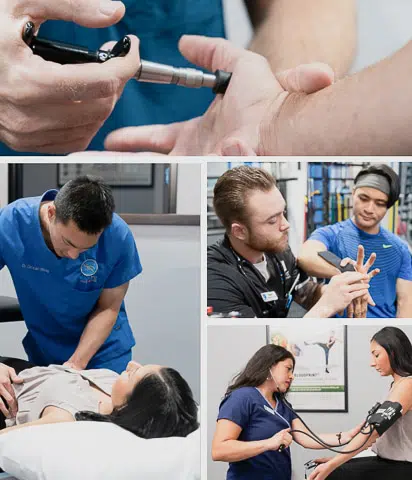Sports Injury

Appointment Inquiries
Call us at: (877) 222-5348
Definition
Injuries commonly caused by overuse, direct impact, or the application of force that is greater than the body part can structurally withstand
Root Causes
Back Pain, Decreased Range of Motion, Foot Pain, Hand Pain, Hip Pain, Joint Pain, Shoulder Pain
Risk Factors
Activity Level, Age, Obesity
Treatments
Chiropractic, KT Taping, Manipulation Under Anesthesia, Orthopedic Sports Medicine, Physical Therapy, RICE, Trigger Point Injections
What are sports injuries?
A sports injury is any kind of harm or damage that occurs during exercise or other physical activity. Any or all of these can contribute to a sports injury: poor training practices, improper gear, or an accident.
Other factors may include overexertion especially when out of shape, not warming up properly, or not stretching enough before or after you engage in any physical activity.
According to a 2016 study, every year nearly 8.6 million people between the ages of 5 and 24 in the United States experience a sports injury. Sustaining a sports injury doesn’t mean that you play a sport necessarily. Sports injuries can happen to any person doing any physical activity.
What are the most common types of sports injuries?
The most common sports injury is to the knee joint. Fifty-five percent of all sports injuries are knee injuries, while the next 20% are shoulder injuries. Elbow injuries claim the next 7%, and the remainder of sports injuries are mostly hamstring strains, sciatica, shin splints, groin pulls, concussions, ACL tears, hip flexor strains, and more.
While some injuries cause more damage and can be more painful, all sports injuries fall under two categories:
- Acute Traumatic Injuries: This type of sports injury includes pulled muscles, sprains, strains, fractures, cuts (or abrasions), and concussions These injuries happen more often if you play contact sports. These include football, basketball, baseball, soccer, and hockey, however, they can also occur whenever there is a blow or force acted upon a person.
- Overuse injuries: This type of sports injury includes muscle tears, tendonitis, and stress fractures. These injuries are most often caused by repetitive sports like running, throwing, swimming, and throwing or serving a ball. This type of injury can happen over time, and if left untreated could lead to a more serious injury or long-term, recurring pain.
Many overuse injuries are named after the sport that causes them most, such as runner’s knee, tennis elbow and golfer’s elbow, pitcher and swimmer’s shoulder.
Bicycling, weight training, volleyball, skiing, gymnastics, wrestling, boxing, martial arts, and other less common sporting activities can also cause an overuse injury.
What are the risks of a sports injury?
Your chance of getting a sports injury can increase for a few reasons:
- Age: Children and seniors have a higher risk of sports injuries. Younger kids are prone to injury due to their higher activity level on average and, for many, child and adolescent awkwardness. Seniors also have a higher risk because, with age, bones and muscles both deteriorate.
- Obesity: Very simply, extra weight increases stress on the entire body, especially the joints of the lower body. Standing, walking, and running impact stresses your knees and hips the most, especially with extra weight.
- Activity Level: If you’re just starting to get active again in a sport or exercise, take it slow. Prepare your joints and muscles for the extra strain by learning to warm up and stretch properly before and after. Push yourself further and increase your limits over time.
Whether you’ve been practicing a sport or exercise regularly or you’re just getting started, remember to always warm-up and cool down properly.
What can BackFit do for your sports injury?
If your injury is moderate to severe, please seek emergency medical services. Severe injuries may or may not require surgery.
Before you come in, for minor to moderate injuries that are not an emergency, BackFit Health + Spine doctors recommend the RICE method. RICE stands for Rest, Ice, Compress, and Elevate.
Despite RICE coming under fire in recent years (or at least some professionals attempting to replace it with something better), it is simple, useful, and remains correct without modification. RICE can provide a variety of benefits to a sports injury.
Rest will stop the injury from getting worse, prevent you from reinjuring yourself, and start the healing process. After a minor to moderate injury, rest for 48 hours is recommended, then participating in modified activity can often be resumed.
Ice reduces the inflammatory response and pain from increased blood flow. Either apply ice for 20 minutes every hour or 20 minutes on and 20 minutes off. Ice for up to 48 hours, but don’t exceed these rules as healing may be delayed. Be sure to use a towel between your skin and the ice to prevent frostbite.
Compression means pressure. Applying pressure by hand works great in the very short term, but it is difficult to maintain. While your injury is healing, use an elastic bandage or compression sleeve, but not non-elastic tape. Constant compression on an injury can prevent excessive swelling. This can improve temporary and long-term function, can prevent excessive pain, and assist with blood flow to the injured area.
Elevation simply means to raise the injured area closer to or above your heart’s level. Elevation, such as with a stool while sitting for an ankle injury, improves the venous return of blood through your circulatory system. This increased return can reduce both pain and swelling, as well as increase healing rates.
Variations on RICE that we agree with include: hydrate with a lot of water, protect and support the injured area, and diagnose the injury with the appropriate medical professional. We also highly recommend optimal loading, or simply stated, the right exercises for rehabilitation.
When it comes to injury, it’s important to seek medical attention quickly. BackFit offers same-day appointments to help you recover in the fastest and best way possible. All first visits after a sports injury include full diagnostic x-rays and labs if necessary all on-site.
Everyone’s plan is unique because every injury is unique. Your treatment plan toward injury recovery at BackFit could include a combination of chiropractic care, physical therapy, medical care, and orthopedic sports medicine. From adjustments to stretching and exercises to KT taping, medical braces, trigger point injections, and more, we’ve got you covered all in one location.
In severe cases, we may also recommend manipulation under anesthesia, pain management, or more. Your treatment plan will not only help mitigate any pain but work to stabilize the injured area to get you back to your life as quickly as possible.
More About BackFit
Looking to learn more? Explore our locations, treatments, or our new patient offer below or contact one of the BackFit Family of staff to have your questions answered.


